I’ve been hesitant to blog too much about homeschooling because I know most of you don’t homeschool and probably wouldn’t be interested in my droning on and on about it. However, I’ve come to realize recently how much curiosity is out there about how homeschooling works and why someone would choose it.
So I’ve decided to do a weekly(ish) series on homeschooling for a while, describing our day, answering your questions, and sharing some game-like techniques that you can use with your kids whether or not you homeschool.
Being that I was homeschooled for 12 years and I have been informally teaching Ali since she was 18 months old, I feel like I have a bit more information than my years of teaching may imply. I am also not offended or defensive about any questions you want to throw at me, nor do I think that homeschooling is the best option for everyone. I’ll be answering the questions that I’ve already been asked sporadically through the series, and if you have your own questions, please leave them in the comments on this or future posts.
Also: For those of you who do homeschool, I plan on doing a link-up or two. Next Monday (10/8), I’ll be sharing what our homeschool day looks like (including curriculum, structure, and dealing with little brothers), and will give you the chance to link up your day as well. So work on documenting it this week!
Without further annoyingly loquacious ado, Today’s Post.
In true homage to her parent’s geekish tendencies, Ali is crazy about math. One of the benefits of homeschooling is being able to go as fast as a kid desires to go in any particular subject. So although our reading, handwriting, and many other subjects are progressing at a normal pace, math can go much quicker. This keeps her interested, proud of her work, and excited to learn more.
In the first four weeks of Kindergarten, she learned carrying and borrowing in addition and subtraction (With the use of her beloved Place Value Houses), how to solve a multiplication table, and basic fractions.
(Yes, her ability to neatly write numbers needs a bit of improvement. But I figure focusing on computing them has got to be more useful.)
But during all of that learning, she was insistent that she wanted to understand division.
I didn’t start out the year with a math curriculum (although I recently added Miquon to our day), so I was trying to teach her concepts on my own. However, explaining doesn’t come naturally to me, so it took me a few days to come up with inspiration in how to teach it. Finally I realized that I simply needed to use her love of Event Planning to convey the concept. I pulled out the single digit blocks from our Cuisenaire Rods
, and I wrote five boxes on a page. I then told her a story.
“You are throwing a birthday party. You’ve got twenty cupcakes, and five people attending.”
(I wrote names above the boxes as I talked.)
“Mommy…Ali…Noah…Gramamma…and Pop. So you need to divide up your cupcakes evenly between your guests. Can you do that?”
She set to work, and after she had them divided up and she told me how many she gave each person. I then informed her that she had just figured the answer to twenty divided by five.
Hopeless nerd that she is, she was elated.
Thanks to this party planning fun, division quickly outranked multiplication tables as her favorite math game.
After a couple of days of verbal word problems and explaining the problem that she had solved, I switched to just writing the equation and letting her make up the story and fill in the answers.
I tried letting her divide them up without the visual clues of the circles for each person, but she wasn’t cognitively ready for that, so we went back to drawing the circles.
She also didn’t understand why you couldn’t just divide any number by any number like multiplication, so I told her, “Well, it’s complicated.”
…then I realized that I should just teach the kid remainders.
Duh.
So I began drawing an extra, smaller shape, and explained that if she didn’t have an even number to divide between her guests, she could place the extras there.
During one of these lessons, Noah was standing at the pantry door screaming for gummies…which prompted a revelation: eating one’s remainders would make division even MORE fun.
So I gave her a pile of gummies, told her to work her problems with them,
And AFTER she wrote down her answer (so that the sugar didn’t impede her already messy writing,)
She could eat her remainders.
(Yes, our homeschooling has the recurring theme of using high fructose corn syrup to encourage learning.)
(And yes, it makes for very happy students.)
Feel free to ask any questions about homeschooling. I’ll answer anything, and If I don’t know the answer, I’ll find it for you!

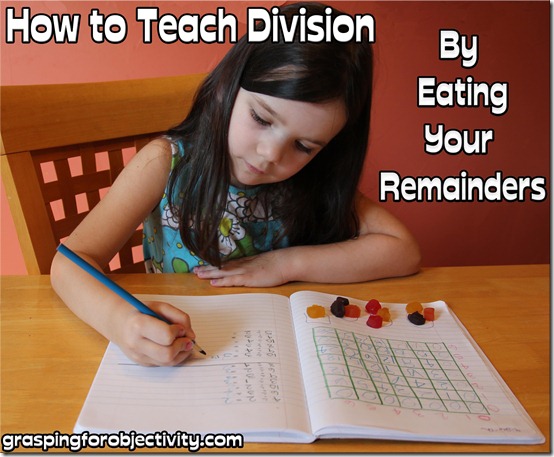
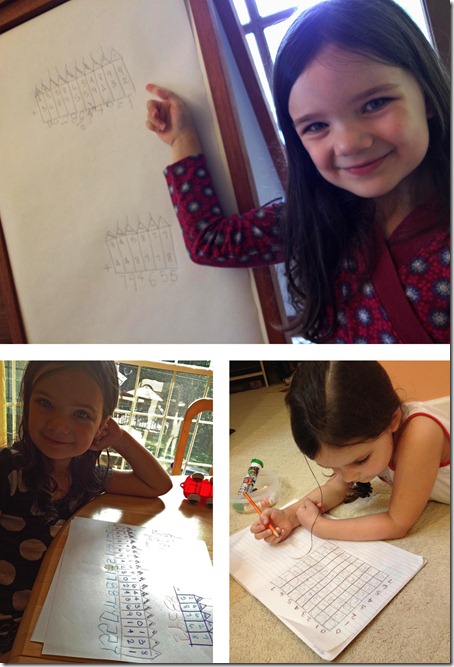
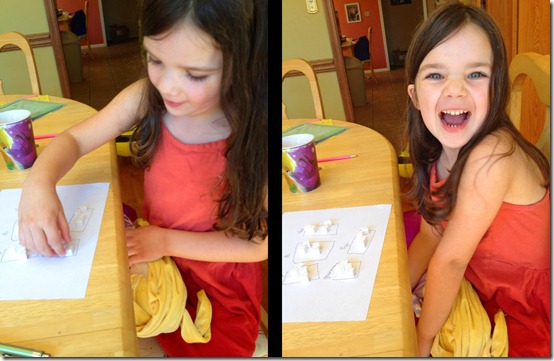
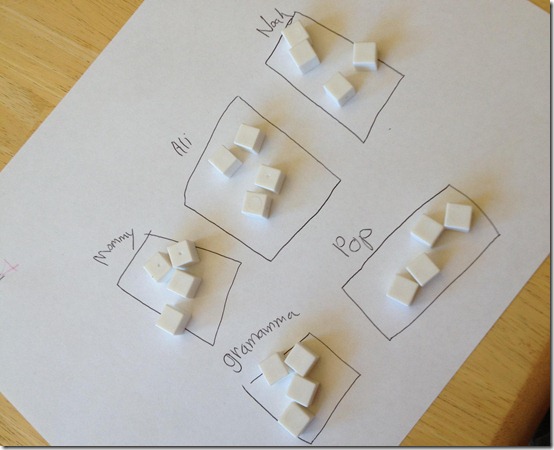
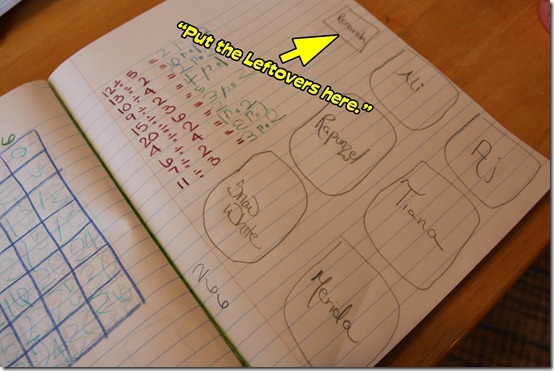
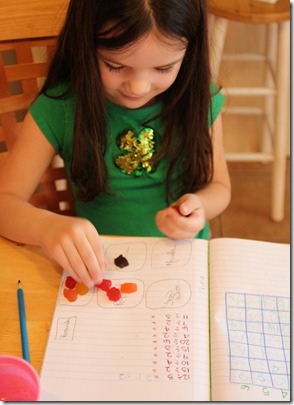
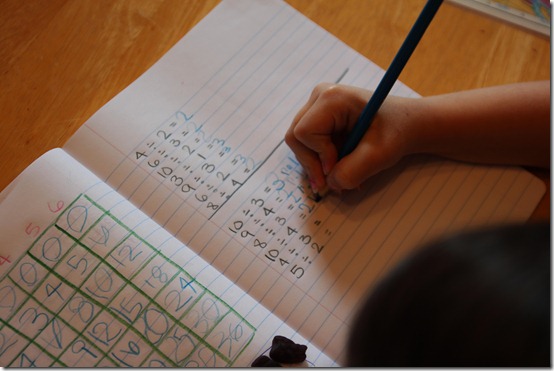
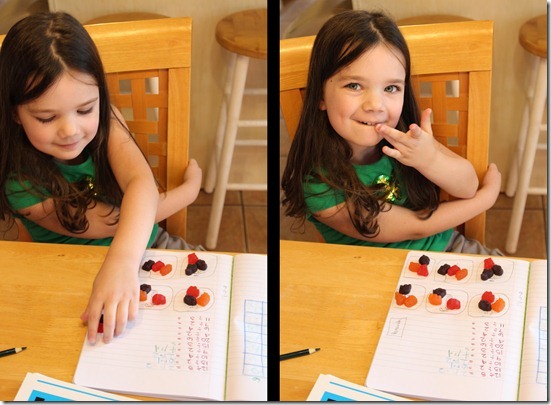
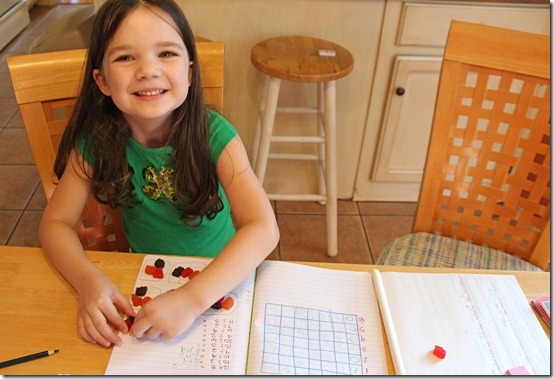

Brilliant! My friend! Just simple Brilliant!!
I gotta tell you, that is way better than how division was explained to me. (And not just because there is candy involved) you may be better at explanations than you think.
The only thing I haven’t figured yet is how to bridge the gap from this to solving in her head. So I’m definitely not better at explanations than you think! :)
I’m so excited that you’re sharing your wisdom! I really, really want to homeschool Anderson but I am completely intimidated! What did you do with Ali at 18 months & how did you decide that was the age to start with her? Anderson loves books & will sit in my lap & let me read to him plus we go to story time where he hears a story & we do music together…i think that’s a start haha! Do y’all do co-ops or any kind of “group learning”? What are your thoughts on those? Ok, I have a million more questions but I’ll only begin with this small bombardment, sorry!
I want to write a post on this, because teaching 18 month olds can look vastly different. Ali had a huge thirst to learn and would sit still for long stretches of time to do it. Noah could care less. He’d rather be running around, throwing things, and playing hard.
But with Ali, she learned her letters and colors at around 18 months. We had a very simple book with large letters and few pictures that we would read over and over and focus on the letters. She picked them up fairly quickly! Noah, on the other hand, just calls all letters “A!!”
I will have to keep this in mind when my son starts division. He starts multiplication this year. (We are homeschooling as well.) Thanks!
I want to know what you are working on with Noah, since he and ak are the same age. AK knows her animals and their sounds and can count to 2. We try to work on colors, alphabet, and numbers, but maybe we are working on too many at one time. I remember you said Ali knew her abc’s by age 2 and could count some too. So my question is … How do you get around the whole highly qualified stuff? Where/how do you get started?
Noah is a different student than Ali was – he has nearly zero educational aspirations, whereas Ali already had her college picked out by this point.
(Okay maybe not her college, but she was on her A-Game.)
He does love animal sounds, so he has those down. But all letters are “A!!!!”, he can’t count but he SURE knows if he’s missing a car, and colors are a thing of complete disinterest.
Basically, we look at picture books and I point out a lot of colors to him. That’s about it.
you are so creative. i have to say it. i think your life of schooling spent homeschooling was way better than my public school experience :) look at the stuff you come up with! i’m gonna book mark this page. i’m looking forward to your post on curriculum. also, we’ve inspired me to push noah in math. the curriculum we bought (my father’s world) is good, but really slow for math in first grade. i think i might order him something else. eventually. ;)
Miquon is a great supplemental curriculum, and really cheap. You might like it!
Fantastic! I will have to keep this in mind for Hazel. Abiah (4th grade)would probably really like it too!
I would have loved math so much more if I got to eat candy with it![: Smart mommy, you are![:
Everything is better with High Fructose Corn Syrup – it’s a proven fact!!
Wow, Ali rocks at math! I might have to steal this idea for my kindergartner, too. I don’t homeschool, but certainly enjoy teaching my kids things anyways.
Making learning fun is the key to everything! Great idea and thank you for sharing.
Awesome post…I’m taking notes. I love that your kindergartener is doing DIVISION! Holy moly. One of the reasons we would like to home school our kids is that like you mentioned, they can move as fast as they want through the subjects that they take interest in. Perfect example!
What a little smarty pants! By 2nd grade, she’ll be begging for calculus! Lol
I hope not – I despise Calculus! Engineer-Daddy will have to come to class.
Great post! I look forward to seeing what else you have to share when it comes to homeschooling/teaching Ali. I don’t home school Ava, but I am always looking for creative ways to help her out with school and practicing school lessons with her. Especially when it comes to Math.
Great post! I am so anxious to get going with homeschooling! I guess that’s a good thing because before I was dreading it. :) I’m really looking forward to reading more posts about it. You always come up with great ideas!
When I was at your house getting my Vault jeans (which I LOVE!!!) and saw Ali doing division, I remember thinking, “Wow, she’s doing division? How old is she?” I agree that using examples about things that kids like (event planning, in Ali’s case) will help them be interested and understand the concepts better. This summer, we used the Kangaroo Roo Cups promotion to further explain the break-even point concept to our kids. Each Roo cup costs $7 and each refill is $0.25, how many drinks do we need to get to break even? We definitely got our money’s worth but we’re now addicted to those icees!
SO COOL!!! I love the way you explained division! As a former high school math teacher, I can say that the majority of my students didn’t even know what division actually meant – they could spit out the answers (or, more accurately, type the question into their handy-dandy calculators and then give me the answer) but they didn’t seem to know/grasp/care about what they were actually doing. I love how you made it into a real-world problem so she isn’t just learning rote memorization.
Things like this are what have made me abandon my staunch no-homeschooling mindset over the past few years and start seriously considering it for our future children. I love my job being a librarian in a public elementary school, and I know that the teachers there do their very best, but there is little chance they would be able to supplement a kid like Ali with more advanced math stuff….she would just have to do whatever the rest of the class is doing, for the most part, and be bored.
Yes, I would say the extreme individualized learning ability is a great benefit for sure. Not to say there aren’t drawbacks (and there are), but it is definitely a good option to consider. I’ll be glad to answer any questions you have whenever!
Great way to do this! I went to a public elementary school, that had a very similar approach to learning. I think teaching kids what they want to learn keeps them interested, even if the are not at the “correct” age yet. As for Ali learning to do it in her head, she will figure it out when her brain is ready for it.
Simple yet fantastic way of teaching remainders! Using the method for my students tomorrow – thank you for sharing!
Thanks so much! I hope it worked well for you!